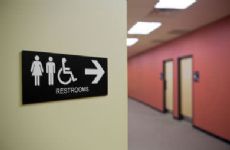|
Editor's Note: Cathy Cram, M.S., is the resident maternal fitness expert on our sister site, BabyFit.com. She writes a monthly series on menopause health and fitness. By Cathy Cram, M.S. One of the first changes many postmenopausal women notice is a subtle shift in how fat is distributed on their bodies. Women who never had much belly fat see the beginnings of a pad of fat the front and sides of their abdomens, and women who have always had a bit of a tummy notice it's much more pronounced. This change in body fat storage after menopause is referred to as the "menopause belly." My own experience with menopause belly started with tummy jiggle whenever I drove over a bumpy road as well as finding that my favorite jeans suddenly were harder to zip up. My abdomen wasn't the area where I normally stored fat (my arms provide that reservoir) so it was a perplexing new problem. I was curious about whether other postmenopausal women experienced the same situation, so I questioned my 50ish friends to see if they'd noticed any changes in the size of their waist. Nearly all of the women I asked lamented about the appearance of their "menopause belly." We all laughed about this new and unwelcome addition, but in reality our expanding waistlines became less funny when entire wardrobes no longer fit. So what does research say about the validity of the menopause belly? Is it the result of hormonal shifts or the penalty for reduced physical activity and excess calories? A study that examined research on menopause-related changes in body fat distribution offers some interesting findings. The researchers stated that studies using waist circumference or waist-to-hip ratio showed no menopause change in body fat distribution compared to premenopausal women. But in contrast, studies that used more high tech measuring tools (duel-energy X-ray absorptiometry, MRI or CT) showed that postmenopausal women had increased trunk fat and intra-abdominal fat levels in comparison with premenopausal women. The data from collective studies on menopausal body fat distribution suggest that starting in early postmenopause there is an associated increase in intra-abdominal fat independent of age and total fat level. Great. It appears that we may not be to blame for this indignity, but I do feel we have some control over the extent of how much belly fat we gain as we age. In my situation, I did some thinking about why I may have put on extra weight and made some focused lifestyle changes to see if they would reduce my middle jiggle. One illuminating association I found was that the appearance of my expanding middle coincided with the end of cross country ski season and the lull before biking weather. My activity level had decreased during the lull (even with my attempt to keep up with some stationary biking and walking) and my caloric intake hadn't changed from what I was taking in during ski season. The bottom line? My body wasn't as metabolically active at 50 as it was at 40, and I needed to add more exercise or cut back on calories. I did a little of both, adding an extra 30 minutes of exercise to my routine and cutting 300 calories in my daily diet. The diet revision required some record keeping to help me determine just how many calories I was taking in each day, and the food record had an added benefit of giving me an overview of the quality of my diet. I chose to stop eating my favorite sugary, fatty snack every night and combined with the extra exercise my "menopause belly" was gone within several months. For the vast majority of postmenopausal women, it's the slow decline in activity level and lack of modification in diet that lead to the body fat changes. The bottom line is we need to increase our exercise level and more closely monitor our diet to maintain our premenopausal body fat level. The key is to make the commitment to the extra effort that's needed to maintain fitness and weight control as we age. Remember, there are two issues associated an expanding tummy: increased body fat and poor abdominal muscle tone. Abdominal exercises won't reduce your tummy fat, but they will help provide support for your abdomen, and as you lose fat the increased muscle tone will give your abs better definition. If you're not willing to go gently into that flabby belly night, then join me in adding a short routine that'll tone your tummy and straighten up your posture. The article linked above features a series of five successive exercises that were developed for postpartum women to help rehabilitate abdominal muscles after pregnancy. I've found that these exercises work great for anyone, and they've become my favorite exercises for strengthening lower abdominal muscles. The best years are to come, so let's focus less on the things we can't change and more on those that we can. No matter how old we get, there's always something we can do to make our life healthier and more intellectually stimulating. You're already on a positive lifestyle track as a SparkPeople member, so by combining the great diet information here with the specialized abdominal exercises featured below, you may trade a menopause belly for a leaner and toned core. Catherine Cram, M.S. is the author of Fit Pregnancy For Dummies, and the owner of Comprehensive Fitness Consulting, LLC. Catherine's company specializes in providing prenatal postpartum fitness information to health-care professionals. Have you experienced "menopause belly"? How did you work to overcome it? |
Popular EntriesRelated Entries
More From SparkPeople
|






















